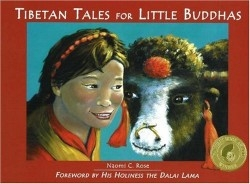Tibetan Tales for Little Buddhas
An impetuous boy begins to realize the wisdom in his father’s peaceful reserve; a girl learns to see the beauty hidden behind superficial ugliness; a young man is compelled to practice compassion toward someone he had feared. These themes reflect familiar truths of human experience, comfortable to modern American readers. But in this volume, the three stories that convey these themes are set half a world away, in the villages of Tibet. The details of place, character, and occupation, of spoken and written language, bring this far-off culture closer to American children.
Although both text and illustrations are occasionally awkward and unpolished, the content of the stories compensates amply. In the first, “Yeshi’s Luck,” a boy and his father are tossed about by fate. Through good fortune and bad, the father retains his equanimity, chanting, “Om mani padme hung,” an appeal to loving kindness in the face of all things. Good and bad are not always as they seem in this story, and as the shifting map of cause and effect unfolds, Yeshi comes to understand his father’s perspective of acceptance.
The second tale, “Jomo and the Dakini Queen,” is at first reminiscent of Cinderella: an unloved, overworked girl fears the angry aunt who is her taskmaster. Instead of being saved by a fairy godmother who takes her away from her tormentors, however, this girl finds a magical mentor who teaches her to transform anger and ugliness. “Cast your fear aside—open your heart wide,” the goddess counsels the girl.
Finally, in “Chunda’s Wisdom Quest,” a young man sets off on the archetypal journey in search of enlightenment. Spraining his ankle, he believes his search to be stalled. But as he waits for healing, he discovers a wounded beast, and must choose between fear for himself and compassion for another.
His Holiness, the Dalai Lama, provides a foreword to this volume, in which he expresses his hopes for the difference that this book may make in the hearts of children around the world.
The author is an established visual artist who has created many graceful paintings depicting the rainforest and the human values to be learned there. In this, her first children’s book, her paintings generously adorn the sensitively translated text. But it is the graceful, exotic script of the Tibetan words at the bottom of each page that provides the most compelling illustrations for these stories, which will give American children a charming introduction to the culture and values of traditional Tibet.
Reviewed by
Bonnie Deigh
Disclosure: This article is not an endorsement, but a review. The publisher of this book provided free copies of the book to have their book reviewed by a professional reviewer. No fee was paid by the publisher for this review. Foreword Reviews only recommends books that we love. Foreword Magazine, Inc. is disclosing this in accordance with the Federal Trade Commission’s 16 CFR, Part 255.

